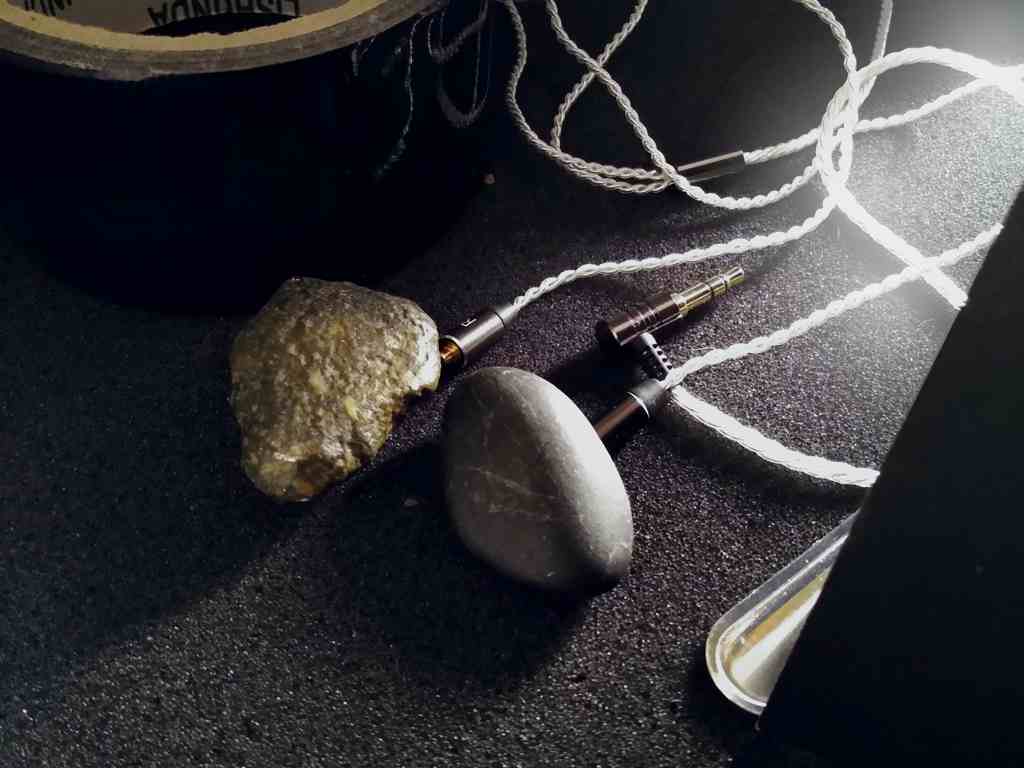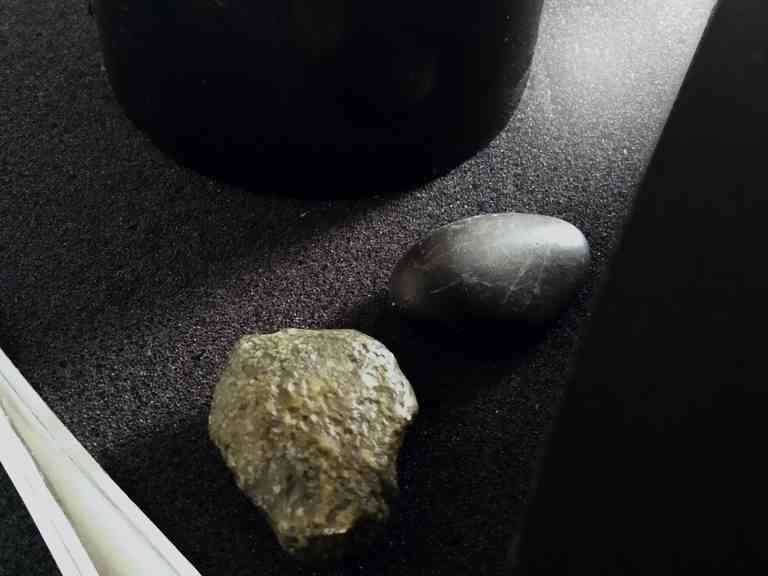Ledig Sten

Ledig is a new startup based in the small town of Taaved (pop. 11) in western Greenland, on an island called Ungratok, in a fiord backed by mountains on the edge of the Arctic icepack. When Ledig promoted this project, I was intrigued and wished to know more. Then when Ledig sent me their latest product, first of an intended production of limited edition, I decided I was eager to try.
The Ledig Sten is made of granite. Granite is largely an equigranular matrix of feldspar and quartz. This material offers many desirable sonic characteristics, such as irregular construction and, with suitable thickness, unmatched rigidity. “In the local language, sten means ‘stone’”, states the Ledig website. “We picked the name because the earphone is made of stone.” Gotta love those guys, far out.
However, my enthusiasm was dampened somewhat when I read the literature kindly supplied by Ledig chief designer, Dong Manhatten. Before I was born, I had queasy feelings about the use of cones in icecream. It always seemed to me that the melting cream would run over my fingers. So when I read that Ledig had built a cone into their latest product, I shivered. Would my fingers get sticky? However, a phonecall to Dong cleared up this misunderstanding, as Dong reassured me there was nothing sticky in the Sten, for which I owe him many thanks. Thankyou, Dong!
Disclaimer
I am but a man who is interested in earphones. Dong kindly provided me with the Stens for the purpose of review. All words are mine, mine, mine. I will testify to my dying breath that I am unbribable. Trust me. I am honest as a hamster. Check my school report.
Accessories
The box containing the Stens opens to spill exotic contents. Out comes a mysterious bag, made of a curious soft material. Doug told me this is XBR‐MMR95EN, with similar properties to 19‐year old aged polar bear hide, but made from recycled plastic. The bag contains nothing but, like the bag of salt in the fairy stories, I shall expect it to reveal at some turn in the story a fundamental role. Inside the bag are several small semi‐transparent lumps of what feels like silicone and resembles overgrown mushrooms. But smaller. I intended to discover what these misshapen fragments may signify, and eventually tracked the information down. They are, of course, the famed eartips, only found on more expensive earphones such as the Sten and the Allegri flagship earphone, the Xanadu‐Silk.
Design
The Sten is a complex of Bezier curvature extended in the third dimension, like pebbles. I believe the silicone mushrooms are intended for insertion to the main pipes, but was unable to make them fit. One advantage of the Stens, as opposed to my usual cotton wool, is that they are easy to grip to insert into an ear. Dong explains, “The usual size of earphone housings is… small. They will not contain a driver large enough to sound over an iceberg.” The Sten’s housing is ridiculously large, 4cm tall. This is accommodated using a novel technique that dates from time immemorial, a fitting adapted from that introduced by the GroovyPeople Lockdown. This allows the main housing of the earphone to cover the ear, then anchors the housing by setting the eartube into a material developed by NASA that resembles Blutack.
The cables and their fittings are high‐value components also. They have been custom commissioned from specialist designer Stefan Nortiger‐Koathanger. Two silver‐plated cables run through a DuraRock polymer Y‐splitter to the gold‐plated plug. The cable, thankfully, is high quality pure silver dual braid decrystalized PH6, which Dong says aids spiritual chakra and reduces microphony. This kind of cable is usually reserved for more expensive earphones such as the Michael CanalBanger. The cable is manufactured by Kosmic, a German company specialising in kitchen utensils. “Earphones are a new venture for Kosmic,” Doug explained in an email, “But they had the technology and materials we needed.” Thank heavens, but the cable has a plug on the end. Overall, the material, machining and finish is exquisite, comparing well to high quality items such as vintage port or a driving licence.
Setup
Comfort is a little compromised due to the Sten’s extended dimensions, but I was able to achieve a good seal by shaving the hair from the sides of my head and utilizing Elastoplast. Your mileage may vary. Isolation is stunningly good, Home listeners will be enthralled, as it is impossible to hear gunfire or the washing machine. I tried crossing the road to the delicatessen, and realised I had not heard a car crash into the nearby Roman wall!
Ledig provide installation instructions with the Sten, but in my haste I ignored these. Having elastoplasted the earphones to my head and settled down with a bagel, I precipitately tried to insert the plug into my mobile phone. It fitted! Bravo, Ledig.

Sound
Tonality
The Sten has the usual WWUL frequency profile associated with earphonic products from the Arctic regions. They have some bumps. But they do not lack bass, like the Carlos Rasputins, they can be seismic. Considering their reasonable asking price, they are mature.
Sub‐bass
The recent recording, ‘Roadworks’ is a daring adventure in Musique concrète, a recording of workmen fixing roads, captured in one uninterrupted take. This recording was mastered by the legendary Mark K. Wright at Bridgend studios. The replay of the Stens was full, deep, controlled and, dare I say it, accurate. With closed eyes I could imagine I was in the midst of live roadworks and participating in manual labour… without, of course, the usual safety muffs!
Bass
The bass of the Stens is awesomely extended, warm and flexible. I have a tape of the prodigy Toearly Xin‐Tang playing a pipe‐organ salvaged from a St. Petersburg church, rebuilt in the marble‐clad main room of the luxury yacht owned by millionaire Divergent Finance Jnr. This is a space I have visited more then a few times, so I can testify that the reproduction of the Sten, perhaps due to sympathy of construction material, was accurate in every stunning detail.
Low‐mids
‘Circular Breathing’ is a recording by bass clarinettist Dave Rechord and percussionist Ratat Nachatki (a digital recording at 256Bit/516KHz, Virtuoso SMS 006). This new music is powerhouse minimalism with a mantric intent, and 13:05 on side two masses a ridiculous density of tone, but the Sten was equal to this, providing differentiation where other earphones sound like a vocal raspberry locked on repeat.
Upper‐mids
The Sten’s overall sonic performance is transparent, letting you see far into the soundstage, and it’s attack is fast and clean. For instance, the limited edition Cologne Direct to Disc recording of Suzie McGooglan plays Astley (BMS 1706 V) is refreshingly entertaining but hardly challenging fare. On the Stens the electric piano was rich sounding and the long sustain and decay produced a studio room sound. The Sten was also bright sounding and the piano was easy to “see” in the space. That said, the Stens are a little behind the best, here. They do not zip well, the Zanzibar Wheelhub achieving more in this verb.
Low‐treble
For years I have kept an untried recording on hand, a transcript from an extraordinary Fundamental Recordings double 45rpm issue by Derek Cullen, ‘Leverage is the Blues’ (Fundamental QL 014). Cullen is a well‐respected blues veteran who I’m sure you’ll enjoy even if for less than twenty seconds. The Sten reproduced Cullen’s vicious guitar string bends as though a chorus line at three‐foot distance. Some $32,000 earphones can capture more of the space, and place triangle relief carvings across the finals, but the Sten does create a chilly sense of distance.
Upper‐treble
The top isn’t as airy as can be. While very well extended (surprisingly so when I played Ionisation [Disque Recordings AE‐23] with Micko ‘Stratosphere’ Trail, Hans Strafe and Pandora Cloud, a record that soars through sonic heights), it doesn’t hit screaming tops with full intensity—dynamics are not fully expressed. Spend a great deal more and you’ll hear white backgrounds but use the Sten in an appropriately‐priced system and you’re probably not missing much. On this count, the Stens are far ahead of the otherwise similar Skaarsgrag NorthLight.
Soundstage/Imaging
The Stens have a narrow soundstage that is remarkably deep. This limits them somewhat. The TenThousandYear Vendetta easily outpaces the Stens in this respect, though the Stens have their seismic low‐mid‐sub‐upper‐bass. Imaging is leprechaun, or on the fuzzy side of the hotel bar, though positions are clean.
Comparisons
Sten vs the Contraband Mouse
The Contraband was a class leader in our May tests, and retained the place it has held on our recommended list for eight years. However, The Sten’s dark ambience is a clear winner in most respects such as timing and decay accuracy, reflecting a list price that is one hundred and fifty times that of the Mouse.
Sten vs. Electric blender
The electric blender has the clearer sound, the Sten has the more extended bass. The midband is somewhat better on the blender, cutting through ambient murk with an insistent sparkle. They are a match for treble. Overall, some will prefer the Sten’s ability to replay sound, though the blender remains undisputed champion of sound generation.
Sten vs. Olivetti Typewriter
The Olivetti is genre classic beloved by generations of audiophiles. And still holds it’s own, producing an upper midband of great clarity. However, the modern engineering of the Sten draws ahead in the extended bass and precision of attack. If you wish to type a letter, you may prefer the Olivetti but, for other sound replay, the Sten draws ahead.
Sten vs. Lausanne granite fireplace
Since they are made of the same material, and cost the same, we tested the Sten against an Lausanne granite fireplace [Lausanne L59GA]. John Jeffery, who is well‐known in this area, paid me a visit and informed me that the Lausanne would be an attractive feature and may raise the price of my apartment by several hundred pounds. Also, for quiet background, the Lausanne was a clear winner, but the Sten then drew ahead in most other areas of sound quality, particularly for it’s airy treble.
Social
It is the burden of a reviewer to describe the pleasurable sensations and privilege that expenditure of currency will provide, not to note frequency accuracy, or if an item is any kop. But I can tell you that, with the Stens fitted to my head, I felt a sense of international overview, and people pointed at me on airplanes. Similarly, it is important to avoid the inegalitarian question of expense, which is $800 USD RSP.
Conclusions
Ledig have a fascinating design with the Sten, engineered with clever ideas, backed by some original but sound thinking. However, the Sten requires some work to gain the best from the technology. So please, at least and as a first step, I recommend you buy a Forge Destatifier to screw to your head. Then you will need Elastoplast to ensure secure fitting. If you do this, the Ledig Sten will reward with a sound that is deep as ruby and kinda useful for the price. The Sten plays with a non‐mechanical sound of micrometer precision that delivers value reinforcement and music. Yes, you can spend less than $8500 USD RSP!
Last note: The Sten has no production run—this is Dong Manhatten’s prototype, to see if he can flog the thing.
